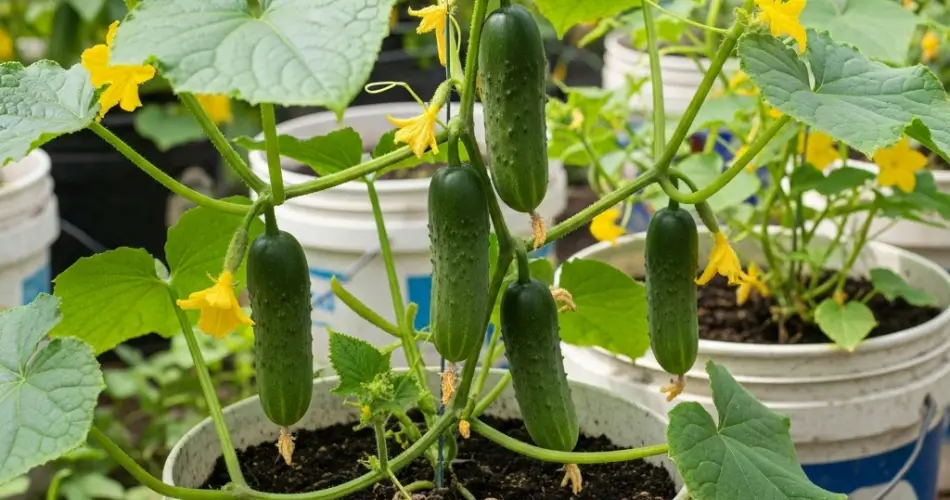Crisp cucumbers are a refreshing addition to summer meals and a key ingredient in homemade pickles. While they are often associated with sprawling garden vines, cucumbers can be grown successfully in pots and containers. This makes them an excellent choice for gardeners with limited space, such as those living in apartments or houses with small yards. With the right setup, you can enjoy fresh cucumbers for salads, sandwiches, and pickling directly from your balcony or patio.
Choosing the Right Variety
Not all cucumbers are ideal for container growing. Since space is limited, compact or bush varieties are best. Look for types labeled as “bush,” “patio,” or “mini.” These are bred specifically to grow well in smaller areas and don’t require as much sprawling room. Pickling cucumbers also tend to be shorter and easier to manage in pots compared to long slicing cucumbers.
Some popular varieties for pots include:
-
Bush Pickle: A compact plant perfect for small containers.
-
Patio Snacker: Bred for container growing with good yields.
-
Salad Bush: Produces tasty slicing cucumbers on short vines.
Selecting the Right Container
Cucumbers need plenty of room for their roots. Choose a container that is at least 12 inches deep and 12–16 inches wide, holding about 5 gallons of soil. Buckets, large pots, or rectangular planters work well. Make sure the container has drainage holes at the bottom to prevent water from pooling, as soggy roots can lead to disease.
If you want to grow multiple plants, consider larger containers or use several pots. Giving each plant enough space will reduce stress and improve fruit production.
The Best Soil for Cucumbers
Cucumbers thrive in well-draining, nutrient-rich soil. Garden soil alone is too heavy for pots and tends to compact, so use a quality potting mix instead. For best results, create a soil blend with the following:
-
Potting mix (50%) for structure and aeration
-
Compost (30%) for organic matter and nutrients
-
Coconut coir or peat moss (10%) for moisture retention
-
Perlite or coarse sand (10%) for better drainage
This blend ensures that roots have access to water without becoming waterlogged. Adding a slow-release organic fertilizer at planting time will provide cucumbers with the nutrients they need in the early stages.
Planting Cucumbers in Pots
Cucumbers can be started from seed or transplanted as young seedlings. If sowing from seed, plant two or three seeds about one inch deep in the container. Once seedlings sprout and develop their first true leaves, thin them to keep only the strongest plant.
For transplants, place the seedling in the container so that the root ball is covered with soil and the stem is level with the surface. Press the soil gently and water thoroughly after planting.
Supporting Your Plants
Even bush cucumbers benefit from some support. A small trellis, tomato cage, or bamboo stakes will help guide the vines upward. This not only saves space but also improves air circulation, reducing the risk of fungal diseases. Keeping cucumbers off the soil also helps prevent rot and produces cleaner fruit.
Watering and Fertilizing
Cucumbers are heavy drinkers and need consistent moisture, especially during hot weather. In pots, the soil tends to dry out faster than in the ground, so check daily and water whenever the top inch feels dry. Deep watering is best—ensure water soaks through the soil and drains out of the bottom.
Fertilization is equally important. Start with a balanced fertilizer during the early growth phase. Once flowers appear, switch to a fertilizer higher in potassium and phosphorus to encourage flowering and fruit development. Organic options such as fish emulsion, seaweed extract, or compost tea are excellent choices that won’t harm soil microbes.
Pollination for Better Harvests
Cucumbers produce both male and female flowers, and pollination is needed for fruit development. If you are growing on a balcony with fewer bees, you may need to hand-pollinate. Simply use a small brush or cotton swab to transfer pollen from male flowers to female ones, which are identifiable by the tiny fruit swelling at the base.
Alternatively, choose parthenocarpic cucumber varieties that can produce fruit without pollination. These are especially useful for indoor or balcony gardeners with limited pollinator activity.
Harvesting Cucumbers
Cucumbers grow quickly once they begin producing. Harvest them when they reach the right size for their variety—usually when they are firm, green, and 4–6 inches long for pickling types, or 6–8 inches for slicing cucumbers. Picking regularly encourages the plant to keep producing.
Overripe cucumbers left on the vine can slow down further production, so check your plants often. Freshly harvested cucumbers can be eaten raw, added to salads, or turned into crunchy pickles.
Final Thoughts
Growing cucumbers in pots is a practical and rewarding gardening project for small spaces. With the right container, nutrient-rich soil, consistent watering, and proper support, you can enjoy a steady supply of fresh cucumbers throughout the season. Whether you prefer them in salads or transformed into tangy pickles, container-grown cucumbers bring freshness and flavor right to your home.
Even with limited space, a few pots can provide more cucumbers than you might expect, making this an ideal crop for beginners and experienced gardeners alike.



